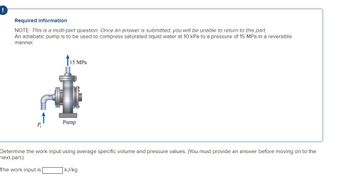
Elements Of Electromagnetics
7th Edition
ISBN: 9780190698614
Author: Sadiku, Matthew N. O.
Publisher: Oxford University Press
expand_more
expand_more
format_list_bulleted
Concept explainers
Question

Transcribed Image Text:Required information
NOTE: This is a multi-part question. Once an answer is submitted, you will be unable to return to this part.
An adiabatic pump is to be used to compress saturated liquid water at 10 kPa to a pressure of 15 MPa in a reversible
manner.
P
15 MPa
Pump
Determine the work input using average specific volume and pressure values. (You must provide an answer before moving on to the
next part.)
The work input is
kJ/kg.
Expert Solution
This question has been solved!
Explore an expertly crafted, step-by-step solution for a thorough understanding of key concepts.
This is a popular solution
Trending nowThis is a popular solution!
Step by stepSolved in 3 steps

Knowledge Booster
Learn more about
Need a deep-dive on the concept behind this application? Look no further. Learn more about this topic, mechanical-engineering and related others by exploring similar questions and additional content below.Similar questions
- pls answer the given correctlyarrow_forward! Required information Problem 08.048 - DEPENDENT MULTI-PART PROBLEM - ASSIGN ALL PARTS - Piston Device with Refrigerant NOTE: This is a multi-part question. Once an answer is submitted, you will be unable to return to this part. A piston-cylinder device initially contains 2 kg of refrigerant-134a at 100 kPa and 20°C. Heat is now transferred to the refrigerant from a source at 150°C, and the piston, which is resting on a set of stops, starts moving when the pressure inside reaches 120 kPa. Heat transfer continues until the temperature reaches 80°C. Assume the surroundings to be at 25°C and 100 kPa. R-134a 100 kPa 20°C Q 150°C Problem 08.048.c - Exergy Destroyed by Piston Device with Refrigerant Determine the exergy destroyed. (You must provide an answer before moving on to the next part.) The exergy destroyed is kJ.arrow_forward3. 0.5 kg of air with a pressure of 2 MPa and a temperature of 250 °C expands while satisfying the relationship of'PV^1.25=constant'. Find what has been done during this process as it expands until the temperature reaches 330 K.arrow_forward
- b) Air with a volume of 0.031 m³ is trapped in a piston-cylinder assembly at a temperature of 40°C and a pressure 102 kPa. The air is compressed adiabatically to a pressure 350 kPa. cv = 0.718 kJ/kg.k and cp = 1.00 kJ/kg. K Determine The work done during this process.arrow_forwardYou work in a company in the energy sector. The competition announces a new turbine that can operate at low temperatures thanks to the use of R134a as the working fluid. According to the competition, this adiabatic turbine has the characteristics shown in the figure below when operating in steady state. (a) How much Power would this turbine generate? (b) Is it possible that it operates as the competition says? Turbina = turbinearrow_forward! Required information NOTE: This is a multi-part question. Once an answer is submitted, you will be unable to return to this part. A piston-cylinder device initially contains 1 kg saturated liquid water at 200°C. Now heat is transferred to the water until the volume quadruples and the cylinder contains saturated vapor only. The saturated liquid properties of water at 200°C 3 are vf= 0.001157 m³/kg and uf- 850.46 kJ/kg (Table A-4). Water mkg 200°C Q Determine the final temperature and pressure. (You must provide an answer before moving to the next part) The final temperature is The final pressure is °C. kPa.arrow_forward
- Calculate the energy requirement to raise the temperature of 1 kg of water from 60 ° C of water to 90 ° C using the following approach; a. Average specific heat usage (Tab A Singh's Book. 4.1) = kJ b. The enthalpy change in the water - vapor saturation table (Tab A Singh's Book. 4.2) = kJarrow_forwardAs shown in the figure, a 320-ft³ tank contains 25 lb of H₂O initially at 30 lbf/in². The tank is connected to a large steam line carrying steam at 200 lbf/in², 450°F. Steam flows into the tank through a valve until the tank pressure reaches p2 = 100 lbf/in² and the temperature is 400°F, at which time the valve is closed. Step 1 Steam at 200 lbf/in.2, 450°F Am 12 = i (1) Valve AD Determine the amount of mass that enters the tank, in lb. lb (1) Determine the amount of mass that enters the tank, in lb, and the heat transfer to the tank from its surroundings, in Btu. Tank Initially: 30 lbf/in.², m₁ = 25 lb (2) Finally: P₂ lbf/in.², 400°F.arrow_forward
arrow_back_ios
arrow_forward_ios
Recommended textbooks for you
 Elements Of ElectromagneticsMechanical EngineeringISBN:9780190698614Author:Sadiku, Matthew N. O.Publisher:Oxford University Press
Elements Of ElectromagneticsMechanical EngineeringISBN:9780190698614Author:Sadiku, Matthew N. O.Publisher:Oxford University Press Mechanics of Materials (10th Edition)Mechanical EngineeringISBN:9780134319650Author:Russell C. HibbelerPublisher:PEARSON
Mechanics of Materials (10th Edition)Mechanical EngineeringISBN:9780134319650Author:Russell C. HibbelerPublisher:PEARSON Thermodynamics: An Engineering ApproachMechanical EngineeringISBN:9781259822674Author:Yunus A. Cengel Dr., Michael A. BolesPublisher:McGraw-Hill Education
Thermodynamics: An Engineering ApproachMechanical EngineeringISBN:9781259822674Author:Yunus A. Cengel Dr., Michael A. BolesPublisher:McGraw-Hill Education Control Systems EngineeringMechanical EngineeringISBN:9781118170519Author:Norman S. NisePublisher:WILEY
Control Systems EngineeringMechanical EngineeringISBN:9781118170519Author:Norman S. NisePublisher:WILEY Mechanics of Materials (MindTap Course List)Mechanical EngineeringISBN:9781337093347Author:Barry J. Goodno, James M. GerePublisher:Cengage Learning
Mechanics of Materials (MindTap Course List)Mechanical EngineeringISBN:9781337093347Author:Barry J. Goodno, James M. GerePublisher:Cengage Learning Engineering Mechanics: StaticsMechanical EngineeringISBN:9781118807330Author:James L. Meriam, L. G. Kraige, J. N. BoltonPublisher:WILEY
Engineering Mechanics: StaticsMechanical EngineeringISBN:9781118807330Author:James L. Meriam, L. G. Kraige, J. N. BoltonPublisher:WILEY

Elements Of Electromagnetics
Mechanical Engineering
ISBN:9780190698614
Author:Sadiku, Matthew N. O.
Publisher:Oxford University Press

Mechanics of Materials (10th Edition)
Mechanical Engineering
ISBN:9780134319650
Author:Russell C. Hibbeler
Publisher:PEARSON

Thermodynamics: An Engineering Approach
Mechanical Engineering
ISBN:9781259822674
Author:Yunus A. Cengel Dr., Michael A. Boles
Publisher:McGraw-Hill Education

Control Systems Engineering
Mechanical Engineering
ISBN:9781118170519
Author:Norman S. Nise
Publisher:WILEY

Mechanics of Materials (MindTap Course List)
Mechanical Engineering
ISBN:9781337093347
Author:Barry J. Goodno, James M. Gere
Publisher:Cengage Learning

Engineering Mechanics: Statics
Mechanical Engineering
ISBN:9781118807330
Author:James L. Meriam, L. G. Kraige, J. N. Bolton
Publisher:WILEY